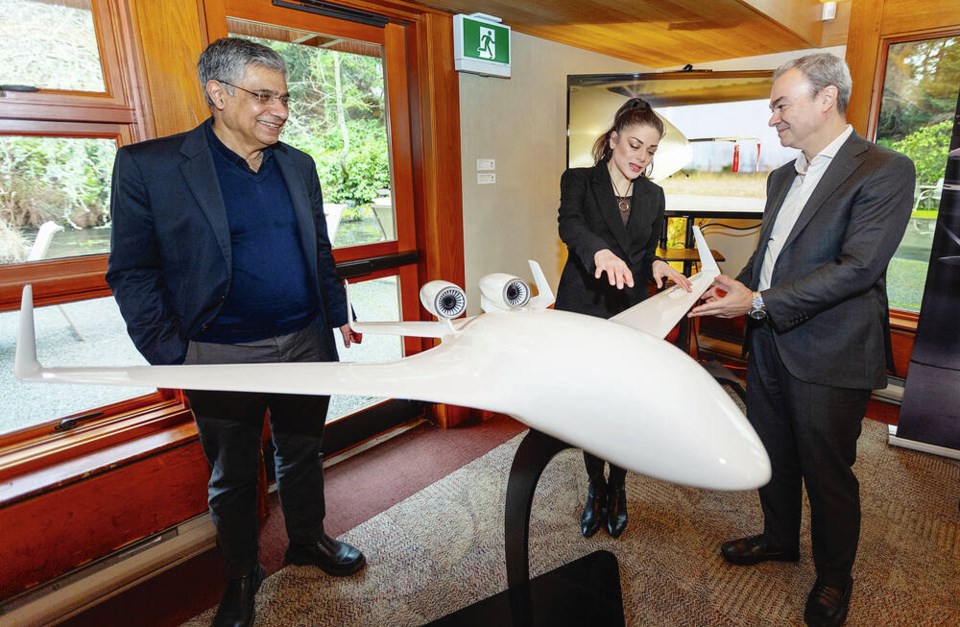Bombardier unveiled the second stage of its new EcoJet aerodynamic prototype developed with the University of Victoria’s Centre for Aerospace Research as the aviation company seeks ways to reduce aircraft emissions.
Fuel use could be cut by 20 per cent if the decade-long partnership achieves hoped-for results thanks to its “radical” blended-wing technology, Pedro Silva, Bombardier’s vice-president of functional engineering, said at the university on Wednesday.
“One of the most pressing challenges that we have in aviation is sustainability.”
The prototype is unique in its configuration, he said. It has been designed to reduce the drag (resistance) of the aircraft during flight, which means less work for the engine and less fuel used, resulting in fewer emissions.
The company figures it can cut fuel use by 50 per cent through three initiatives — the blended-wing design, another 20 per cent through engine propulsion and a further 10 per cent in other changes.
Bombardier is funding research and development of remotely operated prototypes through the Centre for Aerospace Research, based at Victoria International Airport, Silva said.
The project also includes SME Quaternion Aerospace, a local research and development company specializing in design, manufacturing and operation of novel aircraft designs.
EcoJet prototypes can be controlled by a hand-held device, or a van equipped with controls will go to the testing site where people can direct it.
The aircraft are being tested in a variety of locations and conditions, Silva said.
Bombardier is a signatory to the Aviation Industry Commitment for Action for Climate Change, aimed at reducing the impact of air travel on climate change.
At the beginning, the prototype had an eight-foot (2.4 metre) wingspan. This generation is now at 18 feet (5.5 metres), which had its first test flight in 2022.
It is too soon to say when the design might translate into a commercial use, Silva said.
“You don’t rush testing and safety,” he said. Researchers must confirm the aircraft, which transmits data while in the air, responds the way it is supposed to.
“We are progressing very well.”
The current prototype allows testers to fly the craft higher and faster. Related software is adjusted as new data come in.
Afzal Suleman, centre founder and director, is particularly pleased with the long-term impact of the centre.
“The whole endeavour is essentially training of young people in our community. That’s what makes us wake up in the morning and come here.
“We know that we are leaving a legacy for the future.”
The centre pulls in undergraduate clubs at the university, bringing some of the students to the centre, where it has attained the capability to develop experimental aircraft and satellites, Suleman said.
The Bombardier project has created an “ecosystem” of suppliers, as Â鶹´«Ã½Ó³»Island companies support the work in a variety of ways, including creating custom components, he said.
Mina Hoorfar, dean of UVic’s faculty of engineering and computer science, said this is a unique and very long-term partnership between the academic world and Bombardier, one of the most innovative and successful aerospace companies in Canada.
Under Suleman, the centre has grown and expanded its functions to include turn-key research services, design, fabrication, manufacturing, ground testing, and flight testing for a wide variety of applications in aviation and aerospace, Hoorfar said.
It partners with government agencies such as the Department of National Defence, the National Research Council, the U.S. Air Force, and international organizations such as NATO.
The centre has “established itself on the Island as the premier research centre in Canada” for end-to-end development of a range of innovative and experimental aviation technologies, she said.
“It’s all happening right here on this Island.”
>>> To comment on this article, write a letter to the editor: [email protected]



